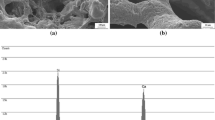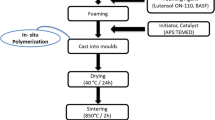Abstract
Glass–ceramic scaffolds mimicking the structure of cancellous bone were produced via sponge replication technique by using a polyurethane foam as template and glass powder below 30 μm as inorganic phase. Specifically, a SiO2-based glass of complex composition and its corresponding P2O5-based “specular” glass were used as materials for scaffolding. The polymeric sponge was thermally removed and the glass powders were sintered to obtain a replica of the template structure. The scaffolds were investigated and compared from a structural, morphological and mechanical viewpoint by assessing their crystalline phases, volumetric shrinkage, pores content and interconnection, mechanical strength. In addition, the scaffolds were soaked in acellular simulated body fluid to investigate their in vitro behaviour. The produced scaffolds have a great potential for bone reconstructive surgery because their features, such as shape, strength, bioactivity and bioresorption, can be easily tailored according to the end use.












Similar content being viewed by others
References
Hulbert SF, Hench LL, Forbes D, Bowman LS. History of bioceramics. Ceram Int. 1982;8:131–40.
Hench LL. Bioceramics and the origin of life. J Biomed Mater Res. 1989;23:685–703.
Hench LL. Bioceramics. J Am Ceram Soc. 1998;81:1705–28.
Schlickewei W, Schlickewei S. The use of bone substitutes in the treatment of bone defects – The clinical view and history. Macromol Symp. 2007;253:10–23.
Ozawa N, Negami S, Odaka T, Morii T, Koshino T. Histological observations on tissue reaction of the rat calcaneal tendon to sintered hydroxyapatite. J Mater Sci Lett. 1989;8:869–71.
LeGeros RZ. Biodegradation and bioresorption of calcium phosphate ceramics. Clin Mater. 1993;14:65–88.
LeGeros RZ, Lin S, Rohanizadeh R, Mijares D, LeGeros JP. Biphasic calcium phosphate bioceramics: preparation, properties and applications. J Mater Sci: Mater Med. 2003;14:201–9.
Thomson RC, Yaszemski MJ, Powers JM, Mikos AG. Hydroxyapatite fiber reinforced poly(a-hydroxy ester) foams for bone regeneration. Biomaterials. 1998;19:1935–43.
Xigeng M, Tan DM, Jian L, Yin X, Crawford R. Mechanical and biological properties of hydroxyapatite/tricalcium phosphate scaffolds coated with poly(lactic-co-glycolic acid). Acta Biomater. 2008;4:638–45.
Hvid I, Jensen NC, Bunger C, Solund K, Djurhuus JC. Bone mineral assay: its relation to the mechanical strength of cancellous bone. Eng Med. 1985;14:79–83.
Keaveny TM, Wachtel EF, Guo XE, Hayes WC. Mechanical behavior of damaged trabecular bone. J Biomech. 1994;27:1309–18.
Hench LL. The story of Bioglass®. J Mater Sci: Mater Med. 2006;17:967–78.
Hench LL, Splinter RJ, Allen WC, Greenlee TK. Bonding mechanism at the interface of the ceramic prosthetic materials. J Biomed Mater Res. 1972;5:117–41.
Hench LL, Wilson J. An Introduction to Bioceramics. Singapore: World Scientific; 1993.
Hench LL. Bioactive materials, the potential for tissue regeneration. J Biomed Mater Res. 1998;41:511–8.
Hench LL, West JK. The sol–gel process. Chem Rev. 1990;90:33–72.
Pereira MM, Clark AE, Hench LL. Calcium phosphate formation on sol-gel-derived bioactive glasses in vitro. J Biomed Mater Res. 1994;28:693–9.
Sepulveda P, Jones JR, Hench LL. Characterization of melt-derived 45S5 and sol–gel-derived 58S bioactive glasses. J Biomed Mater Res. 2001;58:734–40.
Ahmed I, Collins CA, Lewis MP, Olsen I, Knowles JC. Processing, characterisation and biocompatibility of iron-phosphate glass fibres for tissue engineering. Biomaterials. 2004;25:3223–32.
Abou Neel EA, Knowles JC. Physical and biocompatibility studies of novel titanium dioxide doped phosphate-based glasses for bone tissue engineering applications. J Mater Sci: Mater Med. 2008;19:377–86.
Salih V, Patel A, Knowles JC. Zinc-containing phosphate-based glasses for tissue engineering. Biomed Mater. 2007;2:11–20.
Uo M, Mizuno M, Kuboki Y, Makishima A, Watari F. Properties and cytotoxicity of water soluble Na2O–CaO–P2O5 glasses. Biomaterials. 1998;19:2277–84.
Bitar M, Salih V, Mudera V, Knowles JC, Lewis MP. Soluble phosphate glasses: in vitro studies using human cells of hard and soft tissue origin. Biomaterials. 2004;25:2283–92.
Hutmacher DW. Polymeric scaffolds in tissue engineering bone and cartilage. Biomaterials. 2000;21:2529–43.
Vitale-Brovarone C, Verné E, Robiglio L, Appendino P, Bassi F, Martinasso G, et al. Development of glass-ceramic scaffolds for bone tissue engineering: characterisation, proliferation of human osteoblasts and nodule formation. Acta Biomater. 2007;3:199–208.
Vitale-Brovarone C, Miola M, Balagna C, Verné E. 3D-glass-ceramic scaffolds with antibacterial properties for bone grafting. Chem Eng J. 2007;137:129–36.
Vitale-Brovarone C, Baino F, Verné E. High strength bioactive glass-ceramic scaffolds for bone regeneration. J Mater Sci: Mater Med. 2009;20:643–53.
Vitale-Brovarone C, Verné E, Robiglio L, Martinasso G, Canuto RA, Muzio G. Biocompatible glass-ceramic materials for bone substitution. J Mater Sci: Mater Med. 2008;19:471–8.
Vitale-Brovarone C, Bretcanu O, Verné E. Synthesis and characterization of a degradable phosphate glass and its use to produce resorbable scaffolds for bone substitution. J Mater Sci: Mater Med. (2009) (submitted).
Kokubo T, Takadama H. How useful is SBF inpredicting in vivo bone bioactivity. Biomaterials. 2006;27:2907–15.
Hench LL, Wilson J. Surface-active biomaterials. Science. 1984;226:630–6.
Hench LL. Bioceramics: from concept to clinic. J Am Ceram Soc. 1991;74:1487–1510.
Rizkalla AS, Jones DW, Clarke DB, Hall GC. Crystallization of experimental bioactive glass compositions. J Biomed Mater Res. 1996;32:119–24.
Kitsugi T, Yamamuro T, Nakamura T, Kotani S, Kokubo T, Takeuchi H. Four calcium phosphate ceramics as bone substitutes for non-weight-bearing. Biomaterials. 1993;14:216–24.
Radin SR, Ducheyne P. Effect of bioactive ceramic composition and structure on in vitro behavior. III. Porous versus dense ceramics. J Biomed Mater Res. 1994;28:1303–9.
Cao W, Hench LL. Bioactive materials. Ceram Int. 1996;22:493–507.
Vitale-Brovarone C, Baino F, Verné E. Feasibility and tailoring of bioactive glass–ceramic scaffolds with gradient of porosity for bone grafting. J Biomater Appl 2009; doi: 10.1177/0885328208104857.
Chen QZ, Thompson ID, Boccaccini AR. 45S5 Bioglass®-derived glass-ceramic scaffolds for bone tissue engineering. Biomaterials. 2006;27:2414–25.
Vitale-Brovarone C, Verné E, Appendino P. Macroporous bioactive glass-ceramic scaffolds for tissue engineering. J Mater Sci: Mater Med. 2006;17:1069–78.
Schwartz Z, Boyan BD. Underlying mechanisms at the bone-biomaterial interface. J Cell Biochem. 1994;56:340–7.
Acknowledgements
The authors gratefully acknowledge Regione Piemonte (Ricerca Sanitaria Finalizzata 2008) that funded this research work.
Author information
Authors and Affiliations
Corresponding author
Rights and permissions
About this article
Cite this article
Vitale-Brovarone, C., Baino, F., Bretcanu, O. et al. Foam-like scaffolds for bone tissue engineering based on a novel couple of silicate-phosphate specular glasses: synthesis and properties. J Mater Sci: Mater Med 20, 2197–2205 (2009). https://doi.org/10.1007/s10856-009-3788-z
Received:
Accepted:
Published:
Issue Date:
DOI: https://doi.org/10.1007/s10856-009-3788-z




